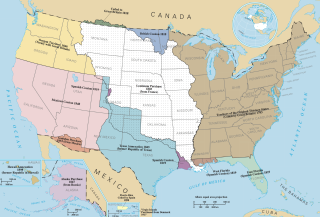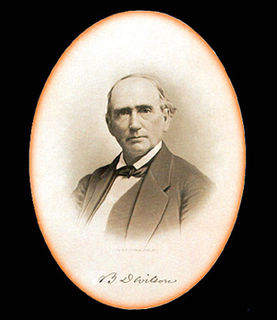Doctor Wilson W. Jones was a California Gold Rush pioneer settler in Los Angeles, California, who acted as county clerk and was also a member of the city's governing body, the Los Angeles Common Council. He is said to have been responsible for the Goldwater family of Arizona establishing itself in that state.

The California Gold Rush (1848–1855) began on January 24, 1848, when gold was found by James W. Marshall at Sutter's Mill in Coloma, California. The news of gold brought approximately 300,000 people to California from the rest of the United States and abroad. The sudden influx of gold into the money supply reinvigorated the American economy, and the sudden population increase allowed California to go rapidly to statehood, in the Compromise of 1850. The Gold Rush had severe effects on Native Californians and resulted in a precipitous native population decline from disease, genocide and starvation. By the time it ended, California had gone from a thinly populated ex-Mexican territory, to having one of its first two U.S. Senators, John C. Frémont, selected to be the first presidential nominee for the new Republican Party, in 1856.
The Los Angeles Common Council was the predecessor of the Los Angeles, California, City Council. It was formed in 1850 under state law, when the city had only 1,610 residents, and it existed until 1889, when the city had about 50,400 residents and a city charter was put into effect.
Barry Goldwater (1909–1998) was an American conservative politician.
Jones was an Easterner whose trek to California was financed by Preston K. Christian. According to the articles of agreement signed by Christian and Marvel M. Jones on May 11, 1850, the other travelers were to be Marvel and Wilson P. Jones, and Christian was to be paid $325 "when they arrive in California." [1]

The Eastern United States, commonly referred to as the American East or simply the East, is the region of the United States lying to the north of the Ohio River and to the east of the Mississippi River.
The above passage refers to a different Wilson W. Jones, and not to the subject of this entry.
Jones became an assistant to Benjamin Davis Wilson, known as "Don Benito," who was elected the first Los Angeles County Clerk in 1850 but who agreed to serve only if Jones would do the actual work; at the same time Jones would receive "all the emoluments of the title." [2] It was explained later by Judge Benjamin Hayes that

Benjamin Davis Wilson was an American politician. He was known to the Native Americans as Don Benito because of his benevolent manner in his treatment of Native American affairs. Wilson, a native of Tennessee, was a fur trapper and trader before coming to California.

Benjamin Hayes, or Benjamin Ignatius Hayes, (1815–77) was an American pioneer who was the first judge of the district court that served Los Angeles, San Diego and San Bernardino counties in California. His seminal rulings are still cited in that state's courts.
Mr. Wilson, occupied with his property, which was fast rising in value and which has been the foundation of a solid fortune, left his office to the care of deputies, among whom Dr. Wilson W. Jones may be mentioned for his efficiency. [3]
In a special election on September 9, 1850, Jones was named to the Los Angeles Common Council. His term ended in May 1851. [4]
Jones was also for a time a part owner of Rancho San Jose de Buenos Ayres, which had been conveyed to him and William T.B. Sanford, an early Los Angeles postmaster. In 1852, Jones sold his half interest in the rancho to Don Benito for $662.75, or 75 cents an acre. [5]

Rancho San Jose de Buenos Ayres was a 4,438-acre (17.96 km2) Mexican land grant in present day Los Angeles County, California given by Governor Micheltorena in 1843 to Maximo Alanis. The area that was given to Alanis now occupies Westwood, UCLA, Holmby Hills, and Bel Air, Los Angeles. The ranch extended from what is now Sepulveda Boulevard to Beverly Hills.
He was a member of the California State Assembly from the First District in 1855–56. [6]
Around 1861 he was part owner of some tin mines in Temescal, California. [7]
It was said that Jones was responsible for the decision of Michael Goldwater, the grandfather of Senator Barry Goldwater, to settle in the territory of Arizona after Michael and his brother Joseph had failed to succeed in a business venture in the Sierra mining town of Sonora, California [8]
The Goldwater brothers did poorly in Sonora and fared no better when they moved to Los Angeles[,] where the brothers had a billiard parlor, bar and a tobacco shop in the Bella Union Hotel. . . . A friendship with a Los Angeles doctor, Wilson W. Jones, turned around the Goldwater story. Dr. Jones had been to the Arizona mining camp at Gila City and convinced Michael of the business possibilities there. [8]
Around 1863 Jones and Michael Goldwater began a freighting business from La Paz to Prescott in Arizona. [8]
On one freighting trip, the Goldwater brothers and Dr. Jones were heading back to the river from Prescott when they were attacked by Mohave Apaches. Doc Jones and Mike were in the lead buggy and Joe was in another buggy just behind them. The Indians began firing and one bullet cut through the doctor's hat, and two shots drilled holes in Mike's hat. Joe was not as fortunate. He was hit in the lower back and another ball lodged in his shoulder. The Indians were driven from their ambush of the Goldwater party by ranchers who had come on the battle scene. Dr. Jones worked on Joe, treating him until the party arrived at a military camp where a surgeon was found. For years Joe carried on his watch chain the ball Dr. Jones had taken from his back. [8]
Jones also lived in Phoenix, Arizona, where his house at 1008 East Buckeye Road is noted as the "oldest standing building" in that city. [9] [10]




